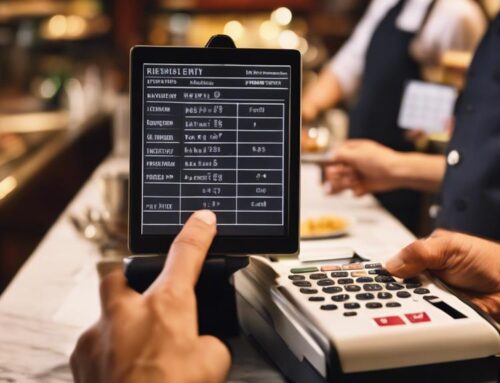For efficient restaurant menu data entry, Excel or Google Sheets are excellent choices. They offer structured entry, formula capabilities, and versatile organization. This enhances accuracy and simplifies operations. Both platforms provide user-friendly interfaces and customization options. Integration with POS systems and reporting features offer valuable insights. Collaboration tools like real-time editing and shared access streamline teamwork. Efficient data organization capabilities simplify tasks like updating prices and ingredients. These factors contribute to smoother processes and optimized menu management. Further insights on features and benefits are available for enhancing your restaurant’s data entry efficiency.
Excel for Menu Data Entry
When entering menu data for your restaurant, Excel provides a versatile and efficient platform for organizing and managing information. Excel ensures data accuracy by allowing you to input prices, ingredients, and descriptions in a structured manner. Through features like drop-down menus and data validation, you can minimize errors and maintain consistency across your menu items. Additionally, Excel’s formula capabilities enable you to perform calculations instantly, such as determining food costs or analyzing sales trends.
Google Sheets for Menu Data Entry
Google Sheets offers a user-friendly interface that simplifies menu data entry tasks. Its collaboration features enable multiple team members to work on the menu simultaneously, enhancing productivity. Additionally, the data organization capabilities of Google Sheets provide a structured way to manage and update menu information efficiently.
User-Friendly Interface
Consider utilizing the intuitive user-friendly interface of Google Sheets for efficient menu data entry tasks. Google Sheets offers mobile compatibility, allowing you to update menus on-the-go seamlessly. Its customization options enable you to structure your menu data according to your restaurant’s specific needs. Additionally, Google Sheets can integrate with your POS system for streamlined menu management. The reporting capabilities of Google Sheets provide valuable insights into menu performance and customer preferences. With a familiar spreadsheet format and easy-to-use functions, Google Sheets simplifies the menu data entry process, making it a practical choice for restaurants looking to optimize their operations. Enhance your menu management efficiency by leveraging the user-friendly interface of Google Sheets.
Collaboration Features
Maximize efficiency by enabling real-time collaboration among your team members when utilizing Google Sheets for menu data entry tasks. Google Sheets allows for real-time updates, fostering seamless team collaboration. With remote access and shared editing capabilities, multiple team members can work on the menu data simultaneously, ensuring that changes are instantly visible to everyone involved. This feature eliminates the need for back-and-forth communication and reduces the chances of errors or version control issues. By leveraging Google Sheets’ collaborative features, your team can work efficiently and harmoniously, making menu data entry a smooth and coordinated process. This real-time collaboration aspect sets Google Sheets apart as an excellent choice for restaurant menu data entry tasks.
Data Organization Capabilities
Enhance menu data organization efficiency by utilizing Google Sheets’ robust capabilities for categorizing, sorting, and filtering data seamlessly. By structuring your menu data in Google Sheets, you can ensure data accuracy by easily organizing items into categories such as appetizers, entrees, or desserts. This categorization enables efficient workflow as you can swiftly locate and update specific menu items without sifting through extensive lists. Additionally, Google Sheets’ sorting feature allows you to arrange menu items alphabetically or by price, streamlining the process of maintaining an organized menu. Filtering options further enhance data organization by enabling you to display only specific categories or items, simplifying tasks such as updating prices or ingredients.
Specialized Software Options
For streamlining restaurant menu data entry tasks, explore specialized software tailored specifically to the food service industry. When considering specialized software options, look for features such as advanced menu item categorization and ingredient tracking functionalities.
Menu item categorization tools in specialized software can help you organize your menu items efficiently. These tools allow you to group items into categories such as appetizers, entrees, desserts, and beverages, making it easier to navigate and update your menu.
Ingredient tracking is another crucial feature to look for in specialized software. With ingredient tracking capabilities, you can easily manage and track the ingredients used in each menu item. This is especially important for tracking allergens, calculating costs, and ensuring accurate inventory management.
Benefits of Custom Database
Consider the advantages of utilizing a custom database for managing restaurant menu data efficiently. Customization options in a database allow you to tailor the system to fit the specific needs of your restaurant. This flexibility enables you to create fields and categories that are relevant to your menu items, making data entry more streamlined and organized. By customizing the database, you can ensure that it aligns perfectly with your menu structure, leading to more efficient data management processes.
Efficiency improvements are a key benefit of using a custom database for restaurant menu data entry. With a customized database, you can design workflows that match the way your restaurant operates, reducing the time and effort required for data entry tasks. Custom databases also allow for automation of repetitive processes, such as updating menu items or prices, further enhancing efficiency. By optimizing the database to suit your restaurant’s unique requirements, you can improve productivity and accuracy in managing menu data.
User-Friendly Interface Considerations
To optimize the efficiency of data entry tasks, prioritize the design of a user-friendly interface that simplifies navigation and streamlines menu item input. When considering design elements for menu data entry software, focus on intuitive layouts, clear labeling, and logical workflows. A well-organized interface should allow users to quickly locate menu categories, add new items, and make updates with minimal effort. Incorporating features like autocomplete suggestions and drag-and-drop functionality can further enhance the user experience, saving time and reducing errors.
Efficiency tips for user-friendly interfaces include customizable templates for different menu styles, allowing for easy adaptation to changing menus. Implementing keyboard shortcuts for common actions can speed up data entry processes. Additionally, providing tooltips or help guides within the interface can assist users in understanding functionalities quickly. Prioritizing responsive design ensures that the software can be used seamlessly across various devices, catering to the needs of different users. By focusing on these design elements and efficiency tips, you can create an interface that facilitates swift and accurate menu data entry.
Data Security and Compliance Factors
When ensuring data security and compliance in restaurant menu data entry software, prioritize encryption protocols and access controls to safeguard sensitive information effectively. Data encryption plays a crucial role in protecting data integrity, ensuring that information is secure both in transit and at rest. Implementing robust encryption mechanisms helps prevent unauthorized access to confidential menu data. Additionally, establishing audit trails within the software allows for tracking and monitoring of all changes made to the menu, aiding in compliance with regulatory requirements.
Adhering to regulatory requirements is essential in maintaining data protection standards. Restaurant menu data entry software should comply with industry-specific regulations to safeguard customer information and business data. By incorporating access controls, administrators can restrict user permissions, ensuring that only authorized personnel can modify menu items. Regular security assessments and updates are necessary to address potential vulnerabilities and enhance overall data security measures. Prioritizing data security and compliance factors in restaurant menu data entry software is critical for protecting sensitive information and maintaining trust with customers.
Cost-Effectiveness and Scalability
To optimize the cost-effectiveness and scalability of restaurant menu data entry software, focus on streamlining operational efficiencies and accommodating future growth seamlessly. Cost efficiency is crucial for businesses of any size, especially in the competitive restaurant industry. Look for software solutions that offer flexible pricing models, such as pay-as-you-go options or scalable pricing tiers based on usage. By choosing software that aligns with your budget and provides value for money, you can ensure long-term cost-effectiveness.
When considering scalability, think about your business growth projections. Select software that can easily grow with your restaurant, whether you are expanding to multiple locations or diversifying your menu offerings. Scalability ensures that your data entry software can handle increased data volume and user requirements without compromising performance. Cloud-based solutions often offer the scalability needed for businesses anticipating growth, allowing you to adjust resources as needed without significant upfront investments. Prioritizing cost-efficiency and scalability in your choice of restaurant menu data entry software sets a strong foundation for future business success.
Frequently Asked Questions
Can I Use Any Other Software for Menu Data Entry Besides Excel, Google Sheets, or Specialized Software Options?
When exploring alternative platforms for menu data entry beyond Excel or specialized software, consider tools like Notion or Airtable. These options offer versatility and customization while maintaining data accuracy crucial for restaurant operations.
How Can I Ensure That My Custom Database Is Set up Correctly for Menu Data Entry?
To ensure your custom database is set up correctly for menu data entry, focus on database optimization to enhance performance. Implement data validation techniques to maintain data accuracy and consistency, ensuring a smooth and efficient process.
Are There Any Specific User-Friendly Interface Considerations I Should Keep in Mind When Choosing Software for Menu Data Entry?
Navigate menu data smoothly with software that offers an intuitive user experience. Prioritize streamlined interface design for efficient data entry. Ensure user-friendly features to enhance productivity and minimize errors in managing menu data.
What Measures Should I Take to Ensure Data Security and Compliance When Entering Menu Data?
To guarantee data security, implement encryption protocols, limit access to authorized personnel, and conduct regular audits. Ensure compliance by adhering to industry standards, training staff on data protection, and maintaining proper documentation for regulatory purposes.
How Can I Determine the Cost-Effectiveness and Scalability of a Software Option for Menu Data Entry in the Long Run?
To determine the cost-effectiveness and scalability of a software for menu data entry, analyze long-term cost projections and conduct scalability analysis. Consider growth potential and future needs to ensure the software can adapt efficiently.




